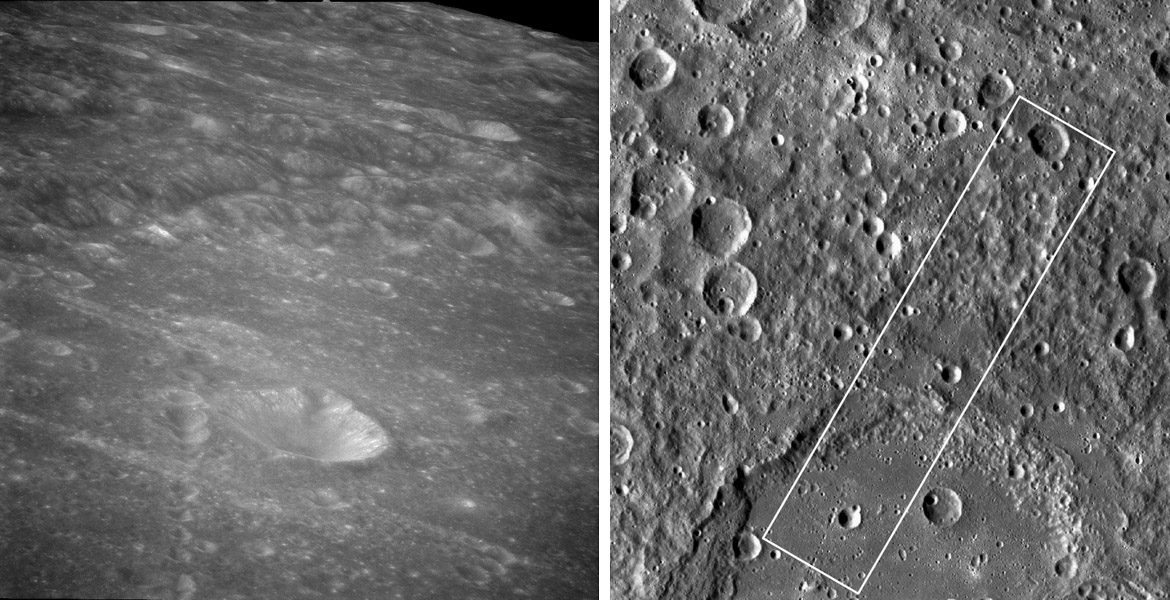Difference between revisions of "May 3, 2013"
| Line 6: | Line 6: | ||
<em>AS11-43-6436 image (left) and LRO QuickMap image selected by [mailto:pleonz@hotmail.com Patricio Leon], Santiago, Chile</em><br /> | <em>AS11-43-6436 image (left) and LRO QuickMap image selected by [mailto:pleonz@hotmail.com Patricio Leon], Santiago, Chile</em><br /> | ||
<br /> | <br /> | ||
| − | Besides their historical achievement of landing on the Moon, the Apollo 11 crew took numerous photos from lunar orbit such as today´s LPOD, where we can see 4 different events that left their footprints on the area around the Mendeleev basin. The stratigraphy suggests the most ancient is a Nectarian (or pre-Nectarian) basin whose SW rim is barely seen at the uppermost edge of the photo; the interior of this ancient basin, [http://lpod. | + | Besides their historical achievement of landing on the Moon, the Apollo 11 crew took numerous photos from lunar orbit such as today´s LPOD, where we can see 4 different events that left their footprints on the area around the Mendeleev basin. The stratigraphy suggests the most ancient is a Nectarian (or pre-Nectarian) basin whose SW rim is barely seen at the uppermost edge of the photo; the interior of this ancient basin, [http://www2.lpod.org/wiki/November_23,_2009 proposed] by C.A.Wood would suffer at an undetermined later time a second concentric impact which gave origin to the Moscoviense basin, perhaps explaining the extreme thinness of the lunar crust there. The second event was the creation of Mendeleev itself, a 313 km-diameter basin with a flat filled floor seen in the foreground of the Apollo image; part of its north-directed ejecta blanket can be seen inside the rectangle at the QuickMap image. The third event would occur [http://www.lpi.usra.edu/meetings/lpsc2013/pdf/2756.pdf before] 3.1-3.4 billion years ago when an impact created Tsiolkovsky crater, 850 km to the SSW. A cluster of chunks ejected northeast may have created the [http://www2.lpod.org/wiki/June_5,_2009 Mendeleev crater chain], the conspicuous vertical line of craters seen at bottom left of the image. The final event likely took place in relatively modern times, only 8 to 10 million years ago, when the Giordano Bruno impact occurred. Part of its ejecta flew 1.300 km east and fell on the Mendeleev floor, giving rise to the striking fresh rays crossing diagonally at center left of the Apollo photo.<br /> |
<br /> | <br /> | ||
<em>[mailto:pleonz@hotmail.com Patricio Leon]</em><br /> | <em>[mailto:pleonz@hotmail.com Patricio Leon]</em><br /> | ||
<br /> | <br /> | ||
<strong>Related Links</strong><br /> | <strong>Related Links</strong><br /> | ||
| − | <em>[ | + | <em>[[21st Century Atlas of the Moon|21st Century Atlas]]</em> chart F1.<br /> |
<br /> | <br /> | ||
<p><b>Yesterday's LPOD:</b> [[May 2, 2013|The Eagle And the Bridge]] </p> | <p><b>Yesterday's LPOD:</b> [[May 2, 2013|The Eagle And the Bridge]] </p> | ||
Latest revision as of 08:33, 28 October 2018
A Chain of History

AS11-43-6436 image (left) and LRO QuickMap image selected by Patricio Leon, Santiago, Chile
Besides their historical achievement of landing on the Moon, the Apollo 11 crew took numerous photos from lunar orbit such as today´s LPOD, where we can see 4 different events that left their footprints on the area around the Mendeleev basin. The stratigraphy suggests the most ancient is a Nectarian (or pre-Nectarian) basin whose SW rim is barely seen at the uppermost edge of the photo; the interior of this ancient basin, proposed by C.A.Wood would suffer at an undetermined later time a second concentric impact which gave origin to the Moscoviense basin, perhaps explaining the extreme thinness of the lunar crust there. The second event was the creation of Mendeleev itself, a 313 km-diameter basin with a flat filled floor seen in the foreground of the Apollo image; part of its north-directed ejecta blanket can be seen inside the rectangle at the QuickMap image. The third event would occur before 3.1-3.4 billion years ago when an impact created Tsiolkovsky crater, 850 km to the SSW. A cluster of chunks ejected northeast may have created the Mendeleev crater chain, the conspicuous vertical line of craters seen at bottom left of the image. The final event likely took place in relatively modern times, only 8 to 10 million years ago, when the Giordano Bruno impact occurred. Part of its ejecta flew 1.300 km east and fell on the Mendeleev floor, giving rise to the striking fresh rays crossing diagonally at center left of the Apollo photo.
Patricio Leon
Related Links
21st Century Atlas chart F1.
Yesterday's LPOD: The Eagle And the Bridge
Tomorrow's LPOD: Topographic Revelations
COMMENTS?
Register, Log in, and join in the comments.



